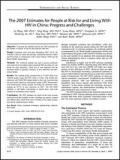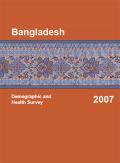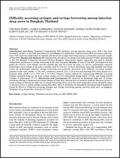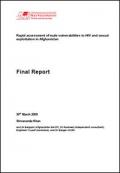What's New
Displaying results 4191 - 4200 of 4914

Resource | Publications,
A second round of estimates and projections was conducted in 2007 to estimate future burden and impacts of HIV/AIDS in order to inform national programs anticipating prevention and care needs in Viet Nam. Similar to the 2003 estimates and projections process, seroprevalence data, population size estimates, and pertinent data from ad hoc studies were entered into the Estimation and Projection Package (EPP) Version 3.0 R9 to generate low, medium, and high scenarios of the HIV epidemic. The epidemic curves generated by EPP were then combined with antiretroviral therapy (ART) and prevention of mother to child (PMTCT) data into a second modeling program, SPECTRUM Version 3.14, for further estimates of prevalence, treatment needs, and AIDS related mortality, among other important data presented in this report. National and region-specific outcomes were generated for the 1990-2012 period in Viet Nam and apply to both the general and high risk populations nationwide.

Resource | Fact Sheets,
The fourth round of Integrated Biological and Behavioral Surveillance (IBBS) Survey among female sex workers (FSWs) was conducted in 2009. A total of 600 FSWs were recruited for the study, out of the 400 were recruited from six study sites representing 16 districts between Jhapa district in the Eastern region and Rupandehi district in the Western region along the highway in the Terai.

Resource | Fact Sheets,
The fourth round of IBBS among truckers was conducted in 2009. A total of 400 truckers were recruited in the sample from the Pathlaiya study site. Data for the study was collected from February 28 to April 25, 2009.
The survey measured HIV and syphilis prevalence among truckers along with information on variables which are associated with a risk of HIV infection and sexually transmitted infections (STIs), such as condom use, sexual behaviors, knowledge of HIV/AIDS, reported cases of STIs, STI treatment behaviors, exposure to HIV/AIDS messages and alcohol and drug use habits.

Resource | Publications,
The Integrated Biological and Behavioral Surveillance (IBBS) survey among truckers was launched on February 20, 2009. A total of 400 truckers were recruited for the study at the Pathlaiya study site. Data for the study was collected between February 28, 2009 and April 25, 2009. The survey measured HIV and syphilis prevalence among truckers along with information on variables which are associated with a risk of HIV infection, such as condom use, sexual behaviors, knowledge of HIV/AIDS, reported cases of sexually transmitted infections (STI), STI treatment behaviors, exposure to HIV/AIDS messages and alcohol and drug habits.

Resource | Publications,
The fourth round of the Integrated Biological and Behavioral Surveillance (IBBS) survey among female sex workers (FSW) in 22 Terai highway districts was launched on February 20, 2009. A total of 600 female sex workers were recruited for the study, out of whom 400 were recruited from six study sites representing 16 districts between Jhapa in the eastern region and Rupandehi in the western region along the highway in the Terai. Another 200 were recruited from three sites representing six districts between Kapilvastu in the western region and Kanchanpur in the far western region. Data for the study were collected from February 28 to April 25, 2009.

Resource | Presentations,
Presentation on Estimating Resource Needs and Gaps for Harm Reduction In Asia at the IHRA’s 20th International Conference, 20-23 April 2009.

Resource | Publications,
The 2007 estimates for the number of people exposed to and infected with HIV in China utilized data newly available through expanded screening and surveillance, while also building on the experience gained during the 2003 and 2005 estimation work. As with past estimates, the workbook method recommended by the World Health Organization (WHO) and United Nations Program on HIV/AIDS (UNAIDS) was chosen as the most suitable for an epidemic still concentrated among certain subpopulations and in a situation where data are still relatively limited.
Populations at higher risk for HIV infection including female sex workers (FSWs), injecting drug users (IDUs), and men who have sex with men (MSM) still make up a large portion of new infections in 2007. However, there are signs that HIV is increasingly becoming a generalized epidemic as sexual contact replaces injecting drug use as the most common mode of transmission.

Resource | Publications,
The 2007 Bangladesh Demographic and Health Survey (BDHS) is a nationally representative sample survey designed to provide information on basic national indicators of social progress including fertility, childhood mortality, contraceptive knowledge and use, maternal and child health, nutritional status of mothers and children, awareness of AIDS, and domestic violence.
In addition to presenting the main findings from the 2007 BDHS on fertility, family planning, maternal & child health and nutrition, this report highlights the major changes that have taken place in Bangladesh's demographic and health situation since the previous BDHS surveys.

Resource | Publications,
Thailand's longstanding HIV epidemic among injection drug users (IDU) has been attributed, in part, to the Thai government's unwillingness to implement evidence-based HIV prevention interventions. This study was undertaken to examine risk factors for syringe borrowing among a community-recruited sample of Thai IDU.
A total of 238 IDU participated in this study; 66 (26.2%) were female, and the median age was 36.5 years. In total, 72 (30.3%) participants reported borrowing a used syringe in the past 6 months, with 47 (65.3%) of these individuals reporting multiple borrowing events. In multivariate analyses, syringe borrowing was positively associated with difficulty accessing syringes [adjusted odds ratio (AOR) = 2.46; 95% confidence interval (CI): 1.08–5.60] and injecting with other people on a frequent basis (AOR = 3.17; 95% CI: 1.73–5.83). Primary reasons offered for experiencing difficulty accessing syringes included being too far from syringe outlets (34.1%), pharmacies being closed (13.6%) and being refused syringes at pharmacies (9.1%).

Resource | Publications,
Between October- November 2008, a small rapid assessment of male adolescent sexual exploitation and abuse, along with HIV risk and vulnerability among males who have sex with males, was conducted in Kabul, Kandahar and Maz-e-Sharif in Afghanistan. Preceding this, a scoping mission, a literature review, and a training workshop for the study teams were conducted.
The findings clearly demonstrate that, as in many other societies, sexual exploitation and abuse of highly vulnerable adolescent males, as well as consensual male-to-male sex exists in Afghanistan at significant enough levels to require an immediate response to the requirements of social justice, health and well-being of these males, and to ensure that the country does not develop a range of concentrated HIV epidemics among males who have sex with males, and highly vulnerable adolescent males over the next few years, adding already to the economic burden that already exists.





